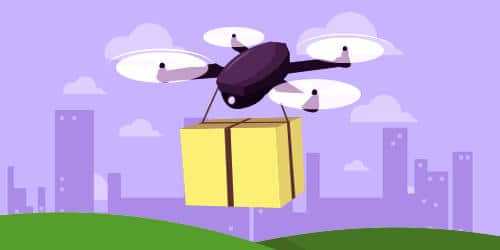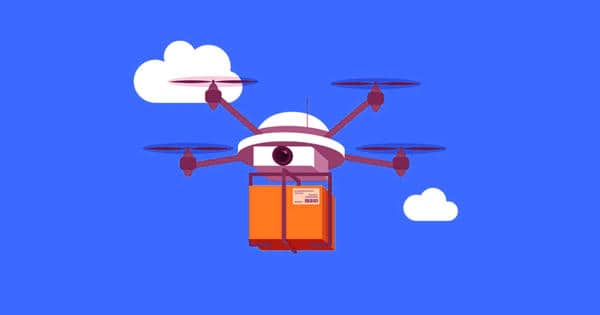Implement drone technology in retail delivery may change logistics networks
Retailers can capture a sizeable portion of the profit of drone delivery by partitioning their market into a few zones. Emerging technologies such as drone delivery services enable retailers to cost‐effectively offer unprecedented delivery speed and adaptable delivery lead times using dedicated aerial vehicles for individual orders. Researchers at The University of Texas at Dallas say drone technology has the potential to be a genuine game-changer in the retail industry, with its promise to enable retailers to offer unheard-of delivery lead times and near-perfect delivery-time customization adaptability. A natural and important question arises: What is the impact of a drone delivery system on a retailer’s extant logistics parameters, for example, the number of customer‐facing delivery centers it uses and delivery lead times it offers?
“Drone delivery will impact more than the transportation of goods. It will also impact how warehouses and distribution centers are designed and laid out.”
To better understand whether drone technology can become a game-changer in retail, researchers at The University of Texas at Dallas recently issued a paper on the subject. In a new study, recently published online in Production and Operations Management, three faculty members from the Naveen Jindal School of Management explored how drone delivery could change retail logistics networks. The paper focuses on the use of customer-facing delivery centers, also known as last-mile warehouses.
On the one hand, the ability to reach customers faster than through traditional means argues for more centralization of delivery services. The study found that both the number of last-mile warehouses and the delivery speed of the drones will increase as the technology matures. In other words, last-mile delivery networks will become more decentralized, with drones operating at increasingly faster speeds. On the other hand, more decentralization can allow the retailer to offer hitherto unheard‐of delivery lead times and thereby spur demand.

The analysis also showed that while perfect customization of delivery-time guarantees is more profitable, retailers can capture a sizeable portion of the profit by partitioning their market into a few zones and offering the best-possible delivery-time guarantee for each zone. On the one hand, drone delivery can enable fast delivery times and minimize the cost of human labor by using dedicated aerial vehicles that fly directly from a delivery center to the customer’s location.
“If a retailer promises each customer a different delivery time based on the customer’s location, that would be perfect customization,” Dawande said. We show that, as drone technology matures and becomes more cost‐effective, delivery networks will become increasingly decentralized while delivering products at faster speeds. “For example, a retailer could give any customer who is 1 mile away from a delivery-time guarantee of five minutes and a customer 1.5 miles away from a delivery-time guarantee of seven minutes. While perfect customization is theoretically best for the retailer, it is impractical. Instead, the retailer might offer all customers less than 5 miles away a guaranteed delivery time of 15 minutes.
The researchers note that increasing the delivery speed of drones can help improve profitability only if it is accompanied by an increase in the number of last-mile warehouses. Therefore, in congested markets, where the number of warehouses cannot be increased, the retailer may find it best to offer a delivery speed that is lower than the highest possible speed. In physically congested metropolitan markets, where retailers may be forced to operate with only a few delivery centers, it may be optimal to operate a DDS by offering delivery guarantees that are inferior to the best possible in order to throttle unprofitable demand.
Drone delivery will impact more than the transportation of goods. It will also impact how warehouses and distribution centers are designed and laid out. “It would be reasonable to assume that drone technology is maturing quickly, and we should see a commercial rollout on a larger scale in the not-too-distant future. The COVID-19 pandemic will perhaps hasten this process,” said Dawande, who is also the Mike Redeker Distinguished Professor in Management.
Today’s warehouses have large docks that determine how quickly goods are entered into inventory or shipped out to customers. Drones might be particularly appealing to customers concerned about both delivery safety and delivery speed, he said. Hands-free delivery to one’s doorstep will be an advantage drone can offer in the post-COVID-19 era. The Covid-19 pandemic has given a tremendous boost to online delivery platforms and retail drone technology will see a commercial roll-out on a larger scale in the not-too-distant future, Indian-origin researchers have stressed.
The obvious change will be the size of the docks. Warehouse managers will no longer need extremely large docks to accommodate fleets of trucks. The researchers noted that further research is needed into how last-mile delivery capacity might be allocated between drones and traditional approaches such as delivery trucks. On the one hand, drone delivery can enable fast delivery times and minimize the cost of human labor by using dedicated aerial vehicles that fly directly from a delivery center to the customer’s location. Drone delivery will revolutionize how retailers fulfill orders, warehouses manage their operations, manufacturers handle inspections, and more.















